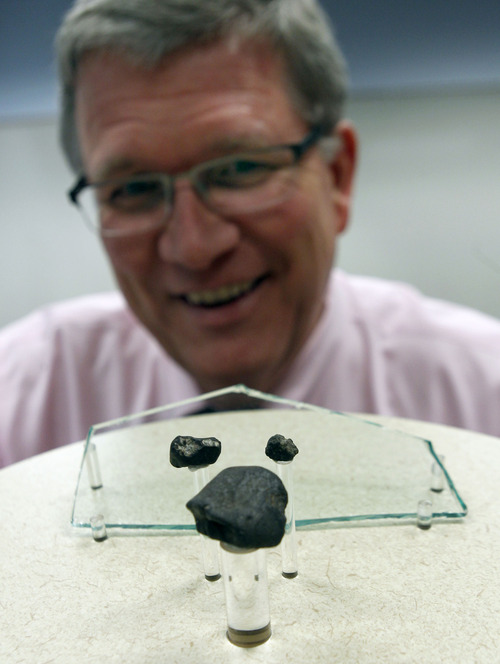This is an archived article that was published on sltrib.com in 2013, and information in the article may be outdated. It is provided only for personal research purposes and may not be reprinted.
A bright flash streaked across the early morning sky.
Spectators rushed to windows and flocked to the streets to get a better look.
Then came the deafening boom. Windows imploded and a factory roof collapsed.
More than 1,100 people were treated for glass-related injuries in the city of Chelyabinsk, Russia, on Feb. 15 after a small asteroid exploded above the city of 1 million.
Now, pieces of the meteorite are on display at Clark Planetarium, along with a chunk of broken glass from one of the hundreds of windows blown in from the force of the space rock exploding in the Earth's atmosphere.
"It was a cosmic dope slap," said planetarium director Seth Jarvis. "It was Mother Nature saying, 'Pay attention!' "
Jarvis hopes the display — which was donated by the ad agency Riester and showcases the small hunks of black, crusted rock and piece of glass under a lighted magnifying glass, along with a monitor showing still photos and a video of the meteor streak and the resulting implosions — will inform viewers of the dangers asteroids present to the planet. He also hopes it lets people know humans can do something about them.
"We know earthquakes are going to happen, tsunamis are going to happen, floods are going to happen and asteroids are going to happen," Jarvis said. "But asteroids are controllable."
With enough warning (years or decades) and enough funding (billions or maybe even a trillion dollars), a planetwide effort could be made to nudge an asteroid off its collision course with the Earth and prevent a species-ending event such as the asteroid that likely wiped out the dinosaurs.
Such an effort would not follow the plot of the science-fiction film "Armageddon," with a last-minute effort to split apart an asteroid hurtling toward the planet. Instead, scientists could use several technologies — from solar sails to reflective paint to gravitational tugs — to gently guide a planet-killer off a collision course.
"It's a lot easier," Jarvis said, "to direct the bullet from a rifle by nudging the barrel as the bullet is being shot instead of trying to move the bullet when it's six inches from your face."
Of course, a planet-killer is about 5 or 6 miles wide and astronomers likely have spotted it already. An asteroid or meteoroid the size of the one that exploded over Russia, which was about the size of a duplex, is much more difficult to spot. The B612 Foundation — named after the home asteroid of the title character in The Little Prince — has proposed the Sentinel Mission, an infrared detection system that would orbit near Venus and detect smaller asteroids that could still wipe out continents or cities.
Had the asteroid that exploded over Russia been made of an iron-nickel mixture instead of its lighter-weight rock, it likely would not have exploded in the atmosphere and instead would have slammed into the Earth, killing hundreds of thousands and devastating the area.
"That day was the universe trying to tell you that this is important and that it matters," Jarvis said. "Chelyabinsk gave us some pretty big clues that we need to be aware of the dangers asteroids pose, and that we can't afford to be clueless about these things."
Twitter: @sheena5427 —
What's in a name?
Meteor • The flash of light seen in the night sky.
Meteoroid • A piece of interplanetary matter that is smaller than a kilometer and frequently only millimeters in size.
Meteorite • Any part of a meteoroid that survives the fall through the atmosphere and lands on Earth.
Asteroid • Larger chunks of rock that come from the asteroid belt located between the orbits of Mars and Jupiter.
Comets • Asteroid-like objects covered with ice, methane, ammonia and other compounds that develop a fuzzy, cloud-like shell called a coma and sometimes a visible tail whenever they orbit close to the sun.
Source: Hubblesite







